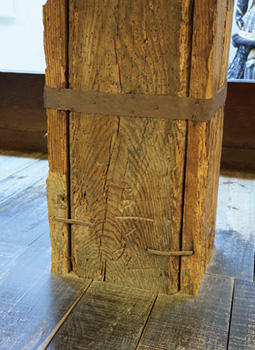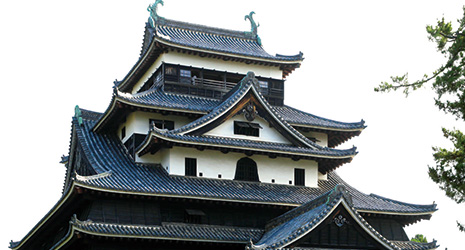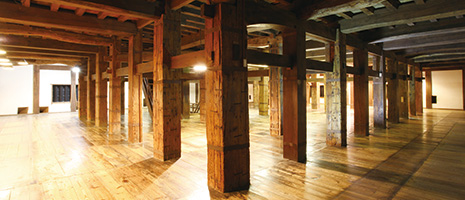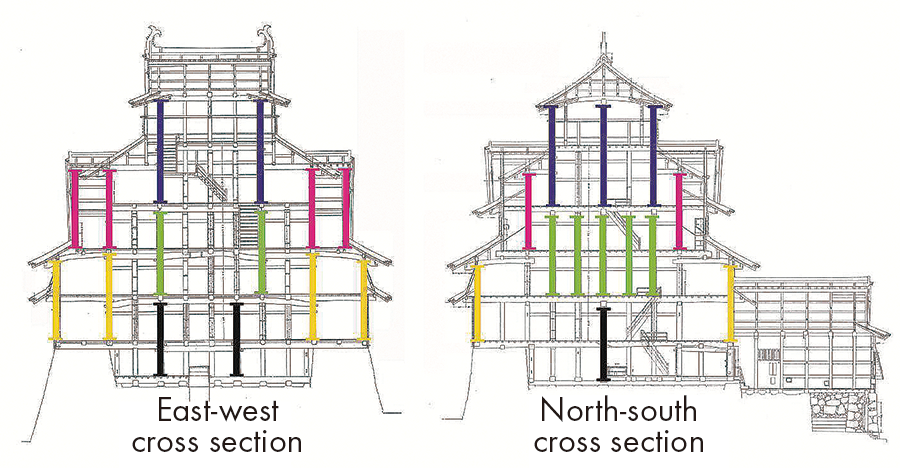INDEX

Pillar reinforcement using the tsutsumi-ita technique
- PREVIOUS
- NEXT
August 2020
The Keep of Matsue Castle

Of the thousands of castles built in Japan over the centuries, there are only twelve that remain in more or less the same form as when they were originally constructed. One of those is Matsue Castle in Shimane Prefecture.

Matsue Castle was built at the beginning of the seventeenth century in the center of what is currently Matsue City, Shimane Prefecture, by Horio Yoshiharu, the feudal lord of the area at the time. Later, the lord of the castle changed, and it became the castle residence for the lord of the Tokugawa Shogunate’s Matsudaira clan, and this continued until feudal domains were abolished and prefectures were established in the early Meiji period, 1871.
The tenshu, or keep, of Matsue Castle was registered by the Japanese government in 1935 as a National Treasure, being one of the most important buildings or works of art in Japan, but the designation was changed from National Treasure to Important Cultural Property due to a change in the jurisdiction law in 1950. However, this change was perceived as a downgrade and a strong desire from city residents was expressed to have the castle, a symbol of Matsue, be reinstated as a National Treasure. Thereafter, patient scientific research, in cooperation with residents and the government, was undertaken to provide the additional information needed for the National Treasure redesignation. The results of this research were announced in 2012. Two talismans were found in a shrine on the castle grounds. These talismans were originally kept hidden in the castle keep, but were lost for hundreds of years. The talismans had the date 1611 inscribed on them, clarifying when the keep was completed. The keep’s characteristic column structure was also explained, and Matsue Castle was redesignated as a National Treasure in 2015, with the determining factors being that the castle was an example of the use of superior techniques in keep construction and that the year of its completion had been revealed.
Part of the characteristic column structure of the keep of Matsue Castle is a technique known as “through pillars.” It ensures the strength of the approximately 30-meter-tall keep, with its five floors above ground and one below ground, dispersing the load of the keep by supporting it with alternating pillars passing through every two floors. At the main keep at Himeji Castle, which was built several years before Matsue Castle, a single long and massive through pillar supported multiple floors, but when Matsue Castle was built, castle construction using enormous logs was going on all over Japan, and it is thought that Matsue Castle was constructed in this way as it was difficult to acquire such enormous logs.
Another technique that reflects the conditions of these times is tsutsumi-ita. This is a technique that covers the surface of the wood used for pillars with boards and fastens them with kasugai (staple-like iron nails) or kanawa (metal bands). Of the 308 pillars supporting the keep, 130 were processed with the tsutsumi-ita reinforcement technique.

It can be said that Matsue Castle was a pioneering building at the time, as it made construction of a large-scale keep possible without using massive, long logs but instead using original techniques, such as the clever use of short pillars.
Even after being redesignated as a National Treasure, studies and research have progressed, and new facts have come to light.
Inata Makoto, head of the Matsue Castle Research Lab, Historical Survey Section, Historical Town Development Department in Matsue City, says, “We have found that when it was built, the roof of the keep was decorated, and it is now assumed that the keep originally had a vastly different exterior than it does today. Up until this new discovery, the common understanding even among castle researchers was that the Matsue Castle keep had entirely preserved its original appearance. The discovery that the keep was in fact different when it was first built has defied the conventional wisdom.”
There has been an increase in opportunities for the castle to be showcased in the media since it was redesignated as a National Treasure, and as the number of tourists from both Japan and abroad has increased, Matsue City is aiming for Matsue Castle to be registered as a World Heritage Site.
Inata says, “In May 2020, the Matsue-jo wo Mamoru Kai (association for protecting Matsue Castle) was established as we entered our fifth year since the National Treasure designation. This association aims to protect Matsue Castle through local efforts and pass it on to the next generation. There are plans to create opportunities to widen the circle of people related to the castle and to carry out activities to promote the network of organizations involved in cleaning and other activities related to the castle. Through sharing and offering the results of our studies and research with city residents, we hope to further increase the value of Matsue Castle.”
It may not be long until we learn of the next discovery of historical facts about Matsue Castle.

- PREVIOUS
- NEXT

